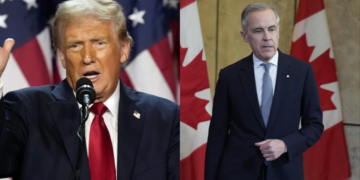As President Donald Trump prepares to unveil sweeping reciprocal tariffs on April 2, 2025, global financial markets are bracing for significant turbulence. The anticipated measures projected to increase import duties by up to 15 percentage points threaten to disrupt trade flows, accelerate inflation, and force investors to rapidly reposition their portfolios. Now the big question is where to invest after Trump’s tariff policy is on a roll.
With Trump’s “America First” trade agenda returning with renewed vigor, industries ranging from automotive to technology face immediate challenges. Meanwhile, sectors such as domestic manufacturing, defense, and commodities stand to benefit from these protectionist policies.
Below is a comprehensive analysis of the most promising investment opportunities in this new era of economic nationalism, along with key risks to monitor.
Trump’s Tariff Policy: Key Details
Fresh from his 2024 electoral victory, President Trump has moved swiftly to reshape U.S. trade policy. Reliable White House sources indicate the April 2 announcement will likely impose:
- China: Expanded tariffs on $350 billion worth of goods, including semiconductors, electric vehicles (EVs), and renewable energy components.
- Mexico & Canada: Potential 10-15% duties on automobiles, steel, and agricultural imports.
- EU & India: Higher levies targeting pharmaceuticals, consumer electronics, and luxury goods.
Goldman Sachs analysts warn these tariffs could:
- Push S. inflation above 4%
- Reduce GDP growth by 0.5-1.0% in 2025
- Elevate unemployment to 4.5% by year-end
The Federal Reserve, already grappling with sticky inflation, may postpone rate cuts, prolonging elevated borrowing costs.
Sectors Facing the Greatest Risk Due to Tariff

- Pharmaceuticals: India’s $18 Billion Generic Drug Trade Under Threat
India supplies 40% of America’s generic medications, but Trump’s tariffs could devastate exporters like Sun Pharma and Dr. Reddy’s. If U.S. duties jump from 2-3% to 10%+, Indian manufacturers may lose pricing power, forcing U.S. consumers to absorb higher drug costs.
- Electronics: A $14.4 Billion Vulnerability
India’s electronics exports (including smartphones and components) currently face just 0.4% tariffs. A steep increase could disrupt supply chains for Apple, Dell, and HP while benefiting U.S.-based chipmakers like Intel and Micron.
- Automotive: North American Supply Chain Disruptions
The U.S. auto sector depends heavily on Mexican and Canadian parts. If Trump imposes 15% tariffs on imported vehicles, Ford and GM may raise prices, potentially slowing EV adoption. Tesla, however, could gain an edge thanks to its U.S.-centric Gigafactories.
- Retail: Walmart, Target Face Profit Squeeze
Big-box retailers sourcing goods from China and Mexico will see costs surge. Walmart has already signaled price hikes on electronics, toys, and apparel, which could weaken consumer demand.
Top Sectors to Invest After Trump’s Tariff Policy
1. Domestic Manufacturing & Industrials (“Made in America” Revival)
Trump’s tariffs aim to boost U.S. production, making domestic industries a prime opportunity.
Best Stock Picks:
- Caterpillar (CAT) – Surging demand for American-made heavy machinery.
- Boeing (BA) – Reduced Airbus competition due to EU tariffs.
- Nucor (NUE) – Steel tariffs will drive higher margins.
2. Energy & Commodities (Inflation Hedge)
Trade barriers typically increase commodity prices, benefiting energy and materials firms.
Top Plays:
- ExxonMobil (XOM) – U.S. shale dominance ensures stable cash flows.
- Freeport-McMoRan (FCX) – Copper demand rises as factories relocate.
3. Gold & Precious Metals (Safe-Haven Assets)
If inflation spikes, gold could surge past $2,500/oz.
Best Gold Exposure:
- Newmont Corporation (NEM) – World’s largest gold producer.
- SPDR Gold Shares (GLD) – Direct gold price tracking.
Smart Investment Strategies for 2025
- While U.S. stocks may benefit, emerging markets like Vietnam and India could suffer. Consider low-cost EMI ETFs but remain cautious.
- Companies with strong cash flows (e.g., Procter & Gamble (PG), Verizon (VZ)) tend to outperform during inflationary periods.
- If the Fed delays rate cuts, bonds may underperform. TIPS (Treasury Inflation-Protected Securities) offer better protection.
Adapt or Risk Falling Behind
Trump’s tariffs will create both challenges and opportunities. While autos, pharma, and retail face headwinds, U.S. industrials, defense, and gold appear well-positioned. As J.P. Morgan, CEO Jamie Dimon recently cautioned: “Trade wars are easy to start but hard to stop. Investors must stay agile.”
Critical Dates to Watch:
- April 2, 2025: Trump’s official tariff announcement.
- May 6-7, 2025: Fed meeting (potential hawkish shift).
- Q2 Earnings (July 2025): Early signs of tariff impact.















Discussion about this post